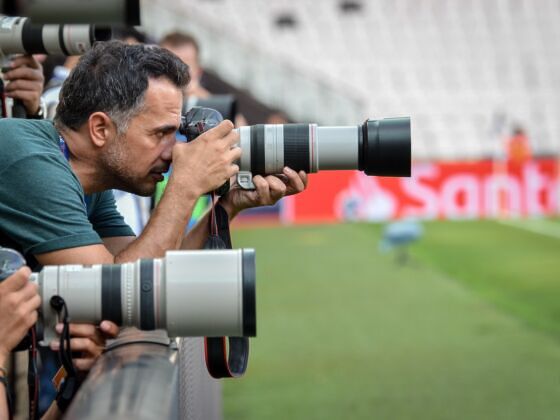GETTING STARTED IN sports photography requires a combination of skills development, artistry, and practice. Often having the proper equipment is a barrier to further skills development. But even amateur photographers can leverage their existing cameras to understand the nuances of sports photography.


Most dSLR cameras come with a sports mode option. While this option doesn’t have all the bells and whistles, it’s a starting point to understanding the camera settings needed for good sports photography.
F-stop, shutter speed, and burst mode are manipulated to capture active shots. A faster shutter speed stops the action to generate more crisp images while turning on burst mode allows photographers to capture more frames per second to capture, for example, the look of disbelief on a player’s face as the ball sails past her racket.
The f-stop filters the amount of light that is able to reach the light sensor. In sports photography, f-stops are typically set toward the wider end of their capabilities to allow the most light to hit the sensor. Combined, a fast shutter speed, wide open f-stop, and burst setting increases the probability of capturing a sharp, clear image in active sports.
Let there be light
Lighting plays an essential role in selecting equipment. In lowlight settings like indoor courts or evening games, photos may turn out blurry and noisy. Often, grabbing a faster lens or using noise reduction software like Noiseware Community Edition will help capture the right moments. Shooting outdoor daylight sporting events first will give newer sports photographers essential practice time without requiring expensive faster lens.
Chances are the players are not going to redo that Hail Mary for your benefit, and there’s no reshoot of a perfect halfpipe ride. Having the ability to read and anticipate the action will give you a better shot at capturing the dramatic moments during the event.This skill separates novice sports photographers from those who consistently and pristinely capture the decisive moments of games
Capturing events off the field may often be more poignant. Even though luck is involved, sports photographers’ most important asset is not the equipment they carry, but their eyes. Be keenly aware of what’s going on in bleachers and on the sidelines.
Another aspect of practing sports photography is gaining access to the players and game. Learning to approach coaches and engage the team prior to the game helps establish a level of trust between the photographer and the players. Friendly coaches hoping to highlight specific athletes for recruiting opportunities may introduce photographers to these key players.
Many photographers start by photographing their friends in pickup games, or friends’ kids at little legaue games. Youth sports allow photographers to get a feel for the right positioning without having to sport photo journalist credentials.
It’s this kind of repetitive practice that leads new photogs to continuous improvement of their skills. After all, that epic shot is worth the risks and countless hours spent perfecting the craft.
Community Connection
Check out these sweet photo essays from Matador Trips.